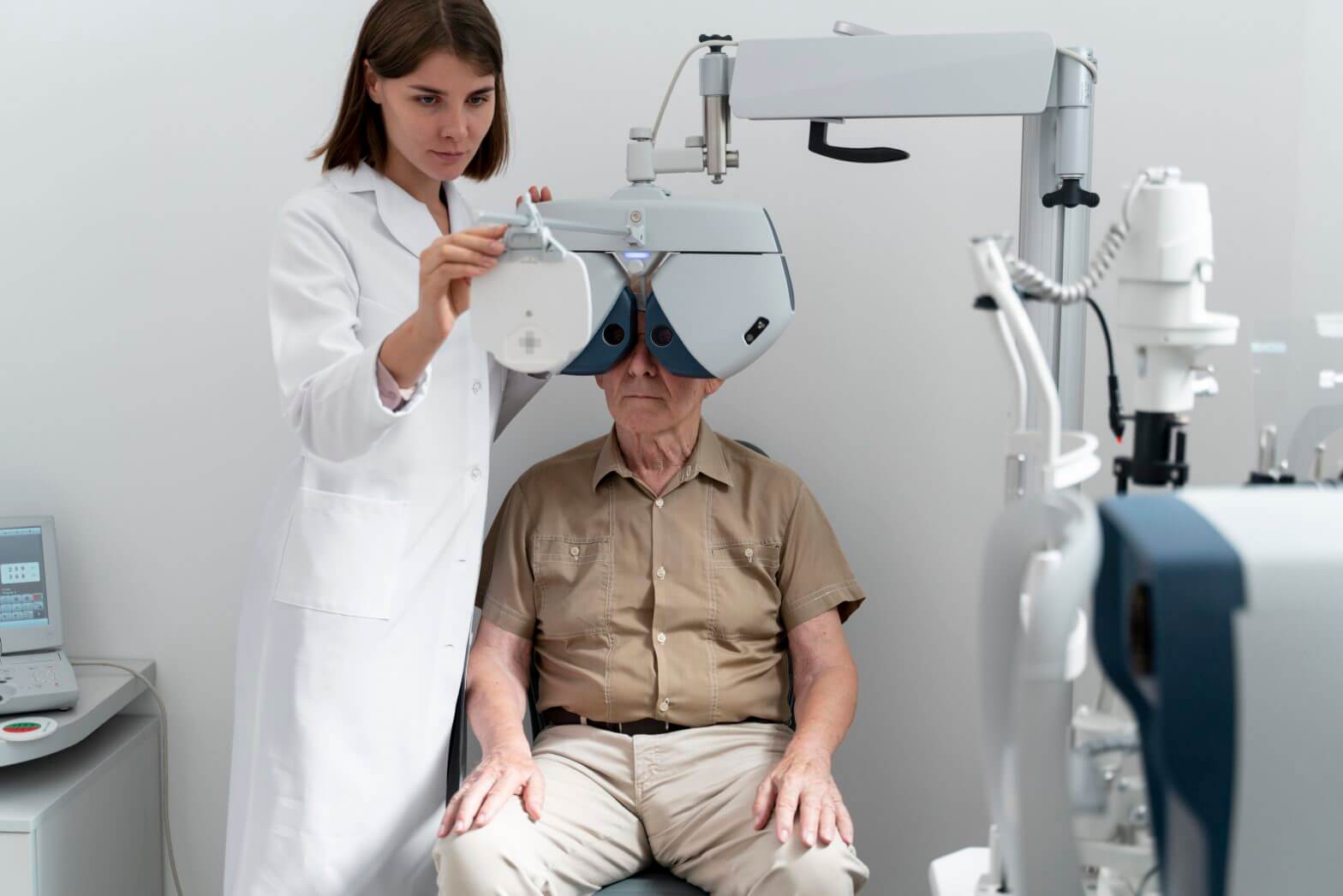Glaucoma is a degenerative eye disorder that destroys the optic nerve, frequently resulting in vision loss if left untreated. Fortunately, there are several treatment options available, including both traditional surgical treatments and advanced laser techniques. In this detailed guide, we’ll look at the differences between the two ways and provide clear explanations to help you decide which is best for you or your loved one.
What is Glaucoma?
Glaucoma is a complex eye condition characterised by damage to the optic nerve, which is responsible for transmitting visual information from the eye to the brain. It can lead to vision loss and blindness if left untreated. This damage is often associated with elevated intraocular pressure (IOP), but glaucoma can also occur with normal or even low IOP in some cases.
Glaucoma is primarily caused by a rise in intraocular pressure, or IOP. This pressure can injure the optic nerve, which is responsible for delivering visual information from the eye to the brain. Damage to the optic nerve can cause irreversible vision loss.
Glaucoma typically advances slowly and is asymptomatic in its early stages, which is why it is known as the “silent thief of sight.” Vision loss usually starts with peripheral vision and can advance to central vision if not corrected. Regular eye examinations are essential for early detection and treatment.
Treatment
The goal of glaucoma treatment is to reduce intraocular pressure in order to protect the optic nerve and retain vision. This can include drugs (such as eye drops), laser therapy (to improve drainage), or surgery (to construct a new drainage pathway). The kind and severity of the glaucoma, as well as the patient’s overall health and preferences, all influence the treatment decision.
Although glaucoma is a chronic condition that must be managed for the rest of one’s life, those who have been diagnosed with it must work closely with their eye care specialists or doctors to monitor their condition and stick to treatment programs in order to maintain vision and quality of life.
Open Angle Glaucoma
The most common type, open-angle glaucoma, causes a gradual increase in pressure within the eye due to insufficient drainage of aqueous humour, the fluid that moisturizes the eye. Over time, this elevated pressure causes damage to the optic nerve, resulting in gradual vision loss, beginning with peripheral vision and proceeding to central vision.
Closed Angle Glaucoma
Closed-angle glaucoma, on the other hand, is less prevalent but more severe. It happens when the drainage angle between the iris and cornea abruptly collapses, resulting in a fast increase in intraocular pressure. This might cause serious symptoms such as eye pain, headache, nausea, and sudden vision loss.
While glaucoma is typically asymptomatic in its early stages, regular eye exams are critical for early identification. Treatment seeks to reduce intraocular pressure in order to avoid future optic nerve injury and preserve eyesight. This can include drugs (such as eye drops), laser therapy (to improve drainage), or surgery (to construct a new drainage pathway). Early detection and treatment are critical to avoiding irreparable vision loss.
Traditional Glaucoma Surgery
Traditional glaucoma surgery involves developing a new drainage channel to lower intraocular pressure. Trabeculectomy is a commonly performed operation. During a trabeculectomy, the surgeon makes a tiny flap in the sclera (the white area of the eye) to allow excess fluid to escape, lowering pressure inside the eye.
Traditional glaucoma surgery seeks to reduce intraocular pressure by constructing a new drainage pathway, usually by a surgical incision. Here’s a video by Dr Soundari from Dr Agarwals Eye Hospital explaining about glaucoma.
Pros and Cons
Pros:
- Effective for decreasing intraocular pressure.
- Long-term results.
- Suitable for advanced glaucoma.
Cons:
- Invasive technique with potential dangers including infection and bleeding.
- Longer recovery period than laser procedures.
- May necessitate continued monitoring and other therapies.
Laser Approaches
Laser treatments for glaucoma are a less invasive option than standard surgery. There are a variety of laser techniques used to treat glaucoma, including:
- Selective Laser Trabeculoplasty (SLT)
- Laser Peripheral Iridotomy (LPI)
- Endoscopic Cyclophotocoagulation (ECP)
Laser techniques use focused beams of light to increase fluid drainage from the eye or limit fluid production, decreasing intraocular pressure.
What are the Pros and Cons?
Pros
- Minimally invasive, with a quicker recovery period.
- There is a lower chance of complications compared to standard surgery.
- Can frequently be conducted as outpatient treatments.
Cons
- The results may not endure as long as standard surgery.
- Some people may need several treatments over time.
- Not appropriate for all forms and stages of glaucoma.
Traditional Glaucoma Surgery Vs Laser Approaches
|
|
Traditional Glaucoma Surgery |
Laser Approaches |
|
Procedure |
Traditional glaucoma procedures, such as trabeculectomy or tube shunt surgery, entail opening up a new drainage pathway for aqueous humour in order to reduce intraocular pressure. |
SLT and LPI are two examples of laser therapy for glaucoma. SLT employs laser light to target particular cells in the eye’s drainage system, improving fluid outflow, whereas LPI inserts a small hole in the iris to promote fluid drainage in closed-angle glaucoma. |
|
Invasive |
These procedures usually entail creating incisions in the eye to construct a new drainage channel or implanting a drainage device. |
These procedures often include creating incisions in the eye to construct a new drainage channel or implanting a drainage device. |
|
Recovery Time |
Traditional glaucoma surgery can take several weeks to heal, and patients may endure discomfort during this time. |
Laser operations typically have a faster recovery time than standard surgery, with most patients able to return to normal activities shortly afterward. |
|
Effectiveness |
Traditional surgeries are often highly effective at lowering intraocular pressure and preventing further optic nerve damage in cases where other treatments have failed. |
Laser treatments can help lower intraocular pressure and can be used alone or in combination with other treatments. |
|
Risks |
Traditional glaucoma surgery carries risks including eye infection, hemorrhage, cataract formation, and, in certain situations, inability to effectively control intraocular pressure.
|
Although laser operations are generally safer than traditional surgery, problems like temporary increases in intraocular pressure or inflammation may occur. |
|
Did you Know? There is a condition known as “normal-tension glaucoma” that causes optic nerve injury and visual loss while having normal intraocular pressure (IOP). Even when the eye pressure is within normal limits, the optic nerve remains injured in this type of glaucoma. Researchers are currently investigating why this occurs and how to cure it, emphasising the complexities of glaucoma as a disorder. |
Am I at risk for glaucoma?
Several factors can raise your chances of having glaucoma. This includes:
- Glaucoma becomes more common as people age, with the risk increasing dramatically beyond the age of 40. People over the age of 60 are at an increased risk.
- If you have a family history of glaucoma, particularly in a first-degree relative (parent, sibling, or child), your chances of having the disease are increased.
- Medical Conditions: Diabetes, high blood pressure, heart problems, and sickle cell anaemia can all raise your chance of getting glaucoma.
- High myopia (nearsightedness), eye damage, and previous eye surgery can all raise your chance of getting glaucoma.
- Eye Pressure: Elevated intraocular pressure (IOP) is a substantial risk factor for glaucoma, while not everyone with high IOP develops the condition, and some persons with normal IOP can develop it.
- People with thinner corneas may be more likely to develop glaucoma.
- Long-term usage of corticosteroid drugs, whether in the form of eye drops, pills, inhalers, or injections, may raise your chance of getting certain types of glaucoma.
Conclusion
Both traditional glaucoma surgery and laser treatments have advantages and disadvantages. The choice between the two is determined by several criteria, including the severity of the glaucoma, the patient’s overall health, and their preferences. Consultation with a capable ophthalmologist is required to identify the best treatment plan. Whether using tried-and-true methods of traditional surgery or cutting-edge laser therapy, the goal is the same: to preserve eyesight and improve the quality of life for glaucoma patients.








